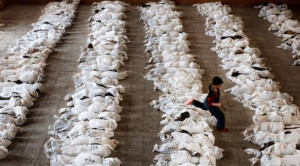As the civil war in Syria shows no signs of de-escalating, worrisome evidence points towards the deployment of chemical warfare with banned agents recently, resulting in almost a hundred deaths with more than a quarter of them children. Chlorine and Sarin gas are primarily being implicated. Here are ten facts to know about Sarin gas and how it works.
(1) Historically, Sarin was used for bioterrorism by members of Aum Shinrikyo, a radical religious cult group in Japan, in 1994 and 1995 that collectively poisoned 6500 people on the subway. In 1998, Saddam Hussein used it against Iranians and Kurdish people. The Syrian government was implicated in an attack on civilians in 2013 that killed 1400 people.
(2) Sarin is a clear, colorless, odorless, and tasteless liquid that transforms into gas and spreads insidiously over long distances to cause damage to the nervous system (thus the name nerve gas). It was accidentally discovered by Germans as a pesticide that seriously poisoned the four scientists who developed it. It is also known as GB [1].
(3) Sarin gas can get absorbed into the body from breathing the air and through the skin and eyes. Liquid Sarin can mix easily with drinking water. Food can get contaminated with Sarin. Occasionally it can linger in the clothes of those exposed and spread easily. The fact that Sarin can cause damage in so many different ways adds to its lethality [1].
(4) Sarin is heavier than air and sinks to lower levels over the ground. Children are more susceptible to Sarin because they are closer to the ground, have smaller bodies, faster breathing rates, immature organ systems, and highly permeable skin [2].
(5) Sarin gas is more potent than liquid and symptoms appear within seconds of exposure to the gas but may take hours with the liquid form. Since it is odorless, victims are unaware of its presence, just like carbon monoxide. Deaths are mostly due to respiratory failure from inhaling the gas.
(6) The lethal dose of Sarin is about 0.5 mg. It is approximately 500 times more lethal than cyanide.
(7) The effects of Sarin are quite similar to organophosphorus poisoning from other pesticides, though much more severe. It inhibits an enzyme in the body called acetylcholinesterase, which is responsible for the breakdown of certain stimulant neurotransmitters. This causes a cholinergic hyper-stimulation state with unopposed high levels of these neurotransmitters in nerves and muscles.
(8) Symptoms include watering of the eyes, runny nose, excess sweating, drooling of saliva, cough, chest pain, rapid breathing, pain in the eye, nausea, diarrhea, and headache and can progress to altered mental status, muscle weakness and twitching, blood pressure changes, seizures, paralysis, and eventually death.
(9) The treatment of Sarin poisoning is three pronged: decontamination, respiratory support, and antidotes, all three to be done simultaneously [3]. Once exposure has occurred it is best to change clothes, wash eyes and body quickly with large quantities of soap and water, pack the clothes in double plastic bags to seal its spread, move out from the area, and go to the highest area possible (since Sarin sinks to the ground). Emergency medical care in a hospital is critical. The best antidote is pralidoxime but due to its cost and lack of easy availability, atropine can also be used. Pralidoxime was found to be effective even 6 hours after exposure and recovery is quick [4]. Supportive measures include aggressive intravenous hydration and diazepam. Personal protective equipment for the rescue units is fundamental and vital.
(10) Long term and subclinical effects of Sarin are not clear. In the Japan attack 8% victims suffered from post-traumatic stress disorder 5 years later [4]. Psychological symptoms were common in victims of both attacks in Japan. Repeated small exposures may or may not cause symptoms that are overt [5].
References:
(1) Centers for Disease Control (CDC). https://emergency.cdc.gov/agent/sarin/basics/facts.asp
(2) Wright LK1 et al. Comparison of the lethal effects of chemical warfare nerve agents across multiple ages. Toxicol Lett. 2016 Jan 22;241:167-74.
(3) Tokuda Y1, Kikuchi M, Takahashi O, Stein GH. Prehospital management of sarin nerve gas terrorism in urban settings: 10 years of progress after the Tokyo subway sarin attack. Resuscitation. 2006 Feb;68(2):193-202. Epub 2005 Dec 1.
(4) Yanagisawa N1, Morita H, Nakajima T. Sarin experiences in Japan: acute toxicity and long-term effects.J Neurol Sci. 2006 Nov 1;249(1):76-85.
(5) Smith CD1, Lee RB2, Moran AV2, Sipos ML2. Repeated low-dose exposures to sarin, soman, or VX affect acoustic startle in guinea pigs.Neurotoxicol Teratol. 2016 Mar-Apr;54:36-45.


27214 977404Hello! Ive been reading your web website for a whilst now and finally got the courage to go ahead and give you a shout out from Kingwood Texas! Just wanted to say keep up the great work! 99805